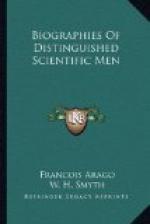I know not whether those persons who will only appreciate things from the peculiar point of view from which they have been accustomed to look, may think there was something strange in several of the details of the ceremony that I have just described. I affirm at least that the whole world will applaud the pious feeling which actuated Sir John Herschel; and that all the friends of science will thank him for having consecrated the humble garden where his father achieved such immortal labours, by a monument more expressive in its simplicity than pyramids or statues.
FOOTNOTES:
[15] When age and infirmities obliged Alexander Herschel to give up his profession as a musician, he quitted Bath, and returned to Hanover, very generously provided by Sir William with a comfortable independence for life.
[16] Sir W. Herschel had married Mary, the widow of John Pitt, Esq., possessed of a considerable jointure, and the union proved a remarkable accession of domestic happiness. This lady survived Sir William by several years. They had but this son.—Translator’s Note.
CHRONOLOGICAL TABLE
OF THE MEMOIRS OF WILLIAM HERSCHEL.[17]
1780. Philosophical
Transactions, vol. lxx.—Astronomical
Observations on the
Periodical Star in the Neck of the
Whale.—Astronomical
Observations relative to the Lunar Mountains.
1781. Phil. Trans., vol. lxxi.—Astronomical Observations on the Rotation of the Planets on their Axes, made with a View to decide whether the Daily Rotation of the Earth be always the same.—On the Comet of 1781, afterwards called the Georgium Sidus.
1782. Phil. Trans., vol. lxxii.—On the Parallax of the Fixed Stars.—Catalogue of Double Stars.—Description of a Lamp Micrometer, and the Method of using it.—Answers to the Doubts that might be raised to the high magnifying Powers used by Herschel.
1783. Phil. Trans., vol. lxxiii.—Letter to Sir Joseph Banks on the Name to be given to the new Planet.—On the Diameter of the Georgium Sidus, followed by the Description of a Micrometer with luminous or dark Disks.—On the proper Motion of the Solar System, and the various Changes that have occurred among the Fixed Stars since the Time of Flamsteed.
1784. Phil. Trans., vol. lxxiv.—On some remarkable Appearances in the Polar Regions of Mars, the Inclination of its Axis, the Position of its Poles, and its Spheroidal Form.—Some Details on the real Diameter of Mars, and on its Atmosphere.—Analysis of some Observations on the Constitution of the Heavens.
1785. Phil.
Trans., vol. lxxv.—Catalogue of Double
Stars.—On
the Constitution of
the Heavens.




